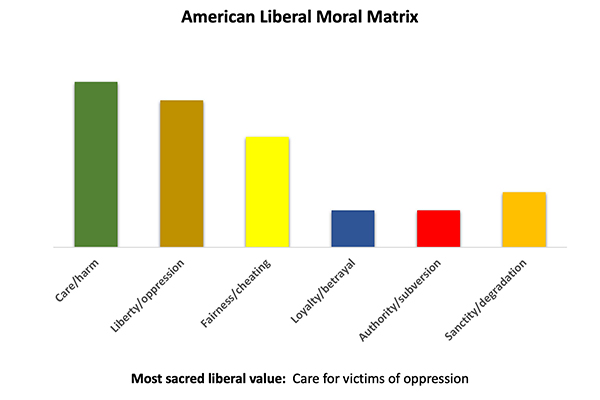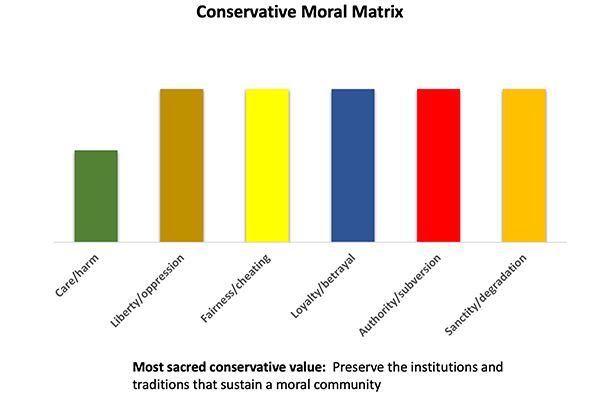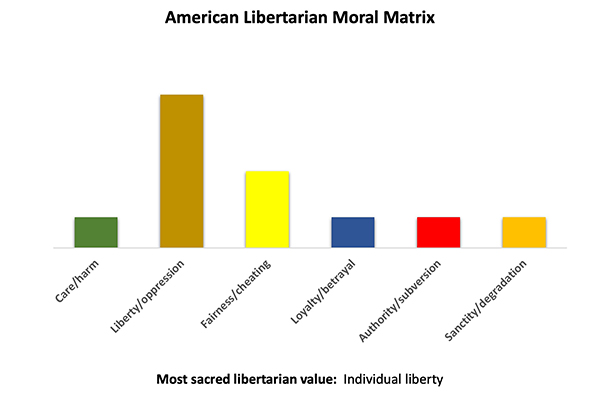Liberals want dogs that are gentle and relate to owners as equals; conservatives want dogs that are loyal and obedient. ~ Jonathan Haidt and Jesse Graham (study)
In previous posts, I identified differences between liberals and conservatives on several psychological dimensions, including social domination orientation and male-female evolutionary “affinity” (aggregate tendencies). I also profiled a significant group of Americans with authoritarian tendencies attached to the Republican party who have some conservative characteristics in the extreme. Most importantly, I introduced the Moral Foundation Theory of Jonathan Haidt in preparation for an in-depth analysis of the six moral foundations in this post.
What do Liberals and Conservatives Really Care About?
Moral Foundation Theory adds remarkable insight to our evolutionary and psychological understanding of political affiliation and answers the central question in this series: What do liberals and conservatives really care about? Furthermore, how can either side understand the other and bridge this blue-red divide? I will save that discussion for an upcoming post, Moral Communication – The Way Forward.
Listen for the Sacred
Another framing of the central question is this: what does each side of the political divide hold as sacred? What are their beliefs that are not subject to persuasion or argument at all? There is an evolutionary basis for most, if not, all moral positions. Each moral stance signals a human adaptation that had utility for thousands of years and retains resonance in modern times. When we listen for what is sacred, we might find a possible “field of empathy” in which to acknowledge and inquire: “I see what is important to you, will you please tell me more?” (More on “listening for the sacred” in Moral Communication – The Way Forward).
The Righteous Mind – Where the Sacred is Found
Developed by acclaimed author and psychologist Jonathan Haidt (The Righteous Mind), Moral Foundation Theory endorses the concept from evolutionary psychology that the human mind is constructed of “modules.” This cognitive architecture is malleable in response to various cultural and social factors, yet is systematically organized as crafted by natural selection. Haidt demonstrates that human moralizing is driven more by intuitive processing than conscious deliberations and rational faculties.
The Six Moral Foundations
Haidt’s research has named six moral foundations that are “innate” (inextricably shaped) in the human experience: Care/harm, Fairness/cheating, Loyalty/betrayal, Authority/subversion, Sanctity/degradation, and Liberty/oppression. Haidt claims that liberals primarily use three foundations – Care/harm, Fairness/cheating, and Liberty/oppression, whereas conservatives utilize all six. Haidt tells us that moral psychology is not just about how we treat one another but also about binding groups together, supporting essential institutions, and living in a sanctified and noble way.
1. Care/harm Foundation
We are a species that thrives when it keeps its young around for a long time and protects them. The Care/harm foundation evolved in response to the adaptive challenge of caring for vulnerable children. It is related to our long evolution as mammals with attachment systems and the ability to feel (and dislike) the pain of others. It makes us sensitive to signs of suffering and need; it makes us despise cruelty and want to care for those who are hurting. It underlies virtues of kindness, gentleness, and nurturance.
Liberals in America rest heavily on the Care foundation in their feelings about people, animals, and victims they do not know directly. For conservatives, care is more often for those who have sacrificed for the group; it is not universalist. It is more local and blended with loyalty.
2. Fairness/cheating Foundation
Cooperation — Not Exploitation
Altruism toward non-kin presented one of the longest-running puzzles in the history of evolutionary thinking. Then Robert Trivers gave us the theory of reciprocal altruism in 1971 and explained the benefit of cooperation and social exchange among non-kin. The Fairness/cheating foundation evolved in response to the adaptive challenge of reaping the rewards of cooperation without getting exploited by free riders. It makes us sensitive to indications that another person is likely to be a good (or bad) partner for collaboration and exchange. The Fairness/cheating foundation makes us want to shun and punish cheaters. It generates ideas of justice, rights, and autonomy.
Tit for Tat
We are a species that evolved to form beneficial alliances – to know what is “fair” for various members of a group trying to stick together. Hunters worked together to bring down prey they could not catch alone. Humans evolved a set of moral emotions that make us play “tit for tat” — emotions that can foster fairness: guilt, shame, revenge, responsibility, generosity, and gratitude. A strategy of “tit for tat” reaped more benefits than a strategy of “help anyone who needs it” (inviting exploitation) or a strategy of “take, but do not give” (which can work only once).
Two Kinds of Fairness
Everyone cares about fairness, but there are two kinds. For liberals, fairness often implies equality and social justice; liberals accuse the wealthy of exploiting people at the bottom and not paying their fair share of taxes.
For conservatives, fairness means proportionality – people should be rewarded in proportion to what they contribute, even if that guarantees unequal outcomes. Conservatives see Democrats as socialists who take money from hardworking Americans and give it to lazy people and illegal immigrants. Years ago, a Tea Party bumper sticker captured one version of proportionality with these words: “Spread my work ethic, not my wealth.”
Reciprocal Altruism is Not the Entire Story
Reciprocal altruism fails to explain why people cooperate in group activities. Reciprocity works great for pairs of people who play tit for tat, but in groups, it is usually not in a person’s self-interest to be the enforcer—to be the one who punishes slackers. But punishment, says Haidt, turns out to be one of the keys to large-scale cooperation. Egalitarianism seems to be more rooted in the hatred of domination and concern for victims than in the love of equality and desire for reciprocity (see Liberty foundation below).
Moral Communities
Cultures developed systems of justice to formalize what each group member is due to keep the group together. “Moral” communities are maintained (in this framework) by gossip and punishment – driven by the desire to protect communities from cheaters, slackers, and free riders who might cause society to unravel.
3. Loyalty/betrayal Foundation
For millions of years, our ancestors faced the adaptive challenge of forming and maintaining coalitions that could fend off attacks from rival groups. The Loyalty/betrayal foundation is related to our long history as tribal creatures. We survived as a species due to loyalty. We are the descendants of successful tribalists. This foundation underlies the virtues of patriotism and self-sacrifice for the group.
We Are Groupish
When Haidt says that human nature is also groupish, he means that our minds contain various mental mechanisms that make us adept at promoting our group’s interest in competition with other groups. We have developed emotions and thinking patterns that help us defend an in-group (people of a similar race, political affiliation, religion, etc.) and reject the out-group.
Origins of Prejudice
The most remarkable of these thinking patterns is prejudice. Our brains quickly size up others as “like me” or “not-like-me.” We take shortcuts to categorize others and assess them as friends or foes.
Heroism or Betrayal
Protecting the in-group takes a particular personality structure, perhaps one with courage and aggression. Predictably, we have developed cultural notions like loyalty and heroism on one side and betrayal or treason on the other.
The Sex/Gender Dynamic
“The male mind appears to be innately tribal,” says Haidt, “that is, structured in advance of experience, so that boys and men enjoy doing the sort of things that lead to group cohesion and success in conflicts between groups, including warfare.” Haidt and Hector Garcia ( Sex, Power and Partisanship) are of one mind on this. “The virtue of loyalty,” Haidt continues, “matters a great deal to both sexes, though the objects of loyalty tend to be teams and coalitions for boys and two-person relationships for girls.”
Matters of Faith
The Koran is full of warnings about the duplicity of out-group members, particularly Jews. But far worse than a Jew is an apostate – a Muslim who has betrayed or simply abandoned his faith. In the Inferno, Dante reserves the innermost circle of hell and the most excruciating suffering for the crime of treason. Far worse than lust, gluttony, violence, or even heresy, is the betrayal of one’s family, team, or nation.
Political Affiliation and Hyperbole
Haidt observes that the Left tends toward universalism and away from nationalism and has trouble connecting to voters who rely on the Loyalty foundation. Ann Coulter’s goal was to highlight that in her book, Treason: Liberal Treachery from the Cold War to the War on Terrorism (2003).
4. Authority/subversion Foundation
The Authority/subversion foundation evolved from our primate history of hierarchical social interactions in response to the adaptive challenge of forging relationships that benefit us within those hierarchies.
Sensitivity to Rank
This foundation makes us sensitive to signs of rank or status and evidence that other people are (or are not) behaving properly, given their position. It underlies virtues of leadership and followership, including deference to legitimate authority and respect for traditions. When exaggerated and combined with the Loyalty/betrayal foundation, this foundation can display in an authoritarian personality.
Looking In Two Directions
Authority-ranking relationships are more complex than relationships in the other foundations because they must look in two directions – up toward superiors and down toward subordinates. We are descendants of individuals who were able to rise in status while cultivating the protection of those in charge.
Survival in Social Hierarchy
While it is true that hunter-gather societies had an egalitarian impulse (see Liberty/oppression foundation below), humans primarily survived because of a developed sense of social hierarchy. Monkeys, bees, and other species show similar organizational patterns. These species coordinate thinking and action through a leader like an alpha male, a queen bee, or a Napoleon. In support of our “fluid functioning hierarchies” (Haidt), we have developed emotions like pride in leadership, awe for power, and respect for others.
Authorities as Parent
Drawing on his fieldwork in Africa, anthropologist Alan Fisk identified the Authority/subversion foundation. Fisk discovered that authority-ranking relationships “are based on perceptions of legitimate asymmetries, not coercive power; they are not inherently exploitative.” Authorities take on responsibility for maintaining order and justice. Fiske showed that people inside these social relationships have expectations more like those of a parent and child than those of a dictator and fearful underlings. This parent-child dynamic is reminiscent of George Lakoff’s (Moral Politics) “strict father family” model described in Root of Our Political Divide – Part 2.
Triggers for Conservatives
If authority is (in part) about protecting order and fending off chaos, then everyone has a stake in supporting the existing order and in holding people accountable for fulfilling the obligations of their station. Triggers for conservatives include any act of disobedience, disrespect, or rebellion against authorities perceived as legitimate. Conservatives will generally oppose actions perceived to subvert the traditions, institutions, or values that provide stability. As with the Loyalty foundation, it is much easier for the political Right to build on the authority foundation than it is for the Left, which often defines itself by its opposition to hierarchy, inequality, and power.
5. Sanctity/degradation Foundation
You Are What You Don’t Eat
Most animals are born knowing what to eat. However, humans had to learn what to eat as omnivores – seeking out new foods while remaining wary of them until they were proven safe. Humans learned to sort from inedible dead things about the same time we developed a large frontal cortex. Evolutionary psychologists and anthropologists say those two developments coincided with the evolution of the human emotion of disgust.
Disgusting Emotion
The psychology of disgust and contamination shaped the Sanctity/degradation foundation. It evolved initially in response to the adaptive challenge of the “omnivore’s dilemma” and then to the broader challenge of living in a world of pathogens and parasites.
Disgust helped shape cultures. We developed the incest taboo, a dislike for the sight and smell of feces and vomit, and a distaste for deformity and disease. Cultures established systems that extended disgust to other body issues, often embracing racial and sexual purity while rejecting non-normative lifestyles, unusual eating patterns, and atypical sexual activity.
Religious Notions
The Sanctity/degradation foundation includes the “behavioral” immune system, which can make us wary of a diverse array of symbolic objects and threats. It causes people to invest in objects with irrational and extreme values (both positive and negative) that are important for binding groups together. The Sanctity foundation underlies religious notions of striving to live in an elevated, less carnal, and more noble way. It underlies the widespread idea that the body is a temple which can be desecrated by immoral activities and contaminants spread by physical touch or proximity.
Triggers for Liberals and Conservatives
Triggers of this foundation are extremely variable and expandable across cultures and eras. For example, present-day American conservatives are more blasé about Covid-19; their allegiance (Loyalty and Authority foundations) to a political tribe overrides their fear of pathogens.
Liberals score higher on “neophilia” (an attraction to new things and openness to experience) and conservatives score higher on neophobia (a fear of new things), preferring to stick to what’s tried and true, guarding borders, boundaries, and traditions. These preferences have their origin in this foundation.
Follow the Sacred
The Sanctity/degradation foundation links to whatever is considered sacred. The psychology of “sacredness” helps bind individuals into moral communities. American conservatives are more likely to talk about the “sanctity of life” and the “sanctity of marriage.” Liberals express Sanctity (purity) by their interest in natural foods, the environmental movement, and concern for the degradation of nature by industrialism and capitalism.
6. Liberty/oppression Foundation
The Liberty/oppression foundation evolved in response to the adaptive challenge of living in small groups and generates feelings of resentment and reaction against people who dominate and restrict others’ liberty. Its intuitions are often in tension with those of the Authority foundation. The hatred of bullies and dominators motivates people to come together in solidarity to take down the oppressor.
Egalitarian Hunter-Gatherers
The archeological evidence supports the view that our ancestors lived for hundreds of thousands of years in tribes of nomadic hunter-gatherers who were egalitarian – they had norms of sharing resources. Therefore, Haidt asks an essential question: are our minds “structured in advance of experience” for hierarchy or equality?
Structured for Hierarchy
Anthropologist Christopher Boehm studied tribal cultures and chimpanzees (Hierarchy in the Forest, 1999) and gave us an answer. Boehm says we were structured for hierarchy — humans and chimps are similar in displays of dominance and submission. Alpha male chimps were not really leaders of their groups. They are better described as bullies.
The Morality of Gossip
During the thousands of years of hunter-gathering, the Liberty/oppression foundation’s moral sensibilities were etched in the human brain as a module of adaptation. Once early humans (pre-agriculture) developed spears, anyone could kill a bullying alpha male. Boehm says our ancestors created the first moral communities about 500,000 years ago, after the advent of language. With language, humans could gossip and unite to shame, ostracize, or kill anyone whose behavior threatened or simply annoyed the rest of the group.
Fragile State
The result is a fragile state of political egalitarianism achieved by creatures innately predisposed to hierarchical arrangements. Boehm called this “self-domestication.” Our ancestors began to “breed” for the ability to construct shared moral matrices and live cooperatively within them. With the development of agriculture, domestication of animals, and staying in place, humans began to create hierarchical social structures — status, rank, and ownership unleashed latent hierarchical tendencies with a vengeance.*
Freedom Fighters Everywhere
The Liberty foundation supports the moral matrix of revolutionaries and freedom fighters everywhere. We find hatred of oppression on both sides of the political spectrum. This foundation supports egalitarianism and anti-authoritarianism of the Left as well as the “don’t-tread-on-me and give-me-liberty anti-government anger of libertarians and some conservatives.
The Three Moral Matrices
Hundreds of people completed the Moral Foundations Questionnaire developed by Jonathan Haidt and Jesse Graham available on YourMorals.org. Those results produced scores on five moral foundations for liberals and conservatives. After additional research on the sixth foundation, Liberty/oppression, Haidt described the moral matrices of liberals, conservatives, and libertarians and depicted them in three separate illustrations in The Righteous Mind. Below is my adaptation of Haidt’s moral matrix summaries and a new rendering (bar graphs) of the foundations for each political orientation. Bar graphs demonstrate default settings of each foundation like dials on a stereo tuner; slight adjustments of strength are activated depending upon the interpersonal context and triggering event.
1. Liberal Moral Matrix
Haidt says liberals have a three-foundation morality: Care/harm, Liberty/oppression, and Fairness/cheating. Liberals apply all three foundations in the service of underdogs, victims, and vulnerable groups everywhere. Much research shows that liberals are more disturbed by signs of violence and suffering compared to conservatives and especially compared to libertarians.
Equality Supersedes Proportionality
All three foundations of the liberal moral matrix support the ideals of social justice. Liberals sacralize care for victims of oppression and equality (fairness). Liberals are often willing to trade away the concept of fairness as proportionality when it conflicts with compassion or their desire to fight oppression. Liberals are suspicious of appeals to loyalty, authority, and some conservative concepts of sanctity. Liberals “sanctify life” by caring for the vulnerable, addressing climate change, preserving animal species, and advocating for the purity of food.

2. Conservative Moral Matrix
Conservatives use all six moral foundations equally, according to Haidt.** He asserts that conservatives’ broader moral matrix allows them to detect threats to “moral capital” (resources that sustain a moral community) that liberals do not perceive. Haidt admits that conservatives are more willing than liberals to sacrifice Care and let some people get hurt to achieve their moral objectives. The most sacred conservative value is to preserve the institutions and traditions that sustain a moral community.
Libertarian Lite
American conservatives also sacralize the word liberty (the right to be left alone), but not to the degree espoused by libertarians. Conservatives do not sacralize equality; they rely on the Fairness foundation once fairness is restricted to what is deemed proportional. The Liberty/oppression foundation and the hatred of tyranny support the tenets of economic conservatism.
Virtues of the In-group
Conservatives are more parochial; they are more concerned about their groups rather than all of humanity. Again, Haidt calls this the groupish adaptation of human nature. Conservatives believe (although rarely stated) that we need groups to develop our virtues even though those groups will necessarily exclude nonmembers.

3. Libertarian Moral Matrix
Libertarians are basically liberals who love markets and lack bleeding hearts. ~ Will Wilkinson, Cato Institute
Libertarian Personality
I contend that if you lack a bleeding heart, you are not like a liberal. But research from YourMorals.org found that libertarians look more like liberals than conservatives on most measures of personality. They score higher than conservatives on “openness to experience” and lower than conservatives on disgust sensitivity and conscientiousness.
Not Like Liberals or Conservatives
Libertarians joined liberals in scoring low on the Loyalty, Authority, and Sanctity foundations. They diverge from liberals sharply (as noted above) on the measures of the Care foundation, where they score very low – even lower than conservatives.
Republican Liberty
Libertarians also diverge from liberals with extremely high scores on measures of economic liberty. People with libertarian ideals have generally supported the Republican party since the 1930s because libertarians and Republicans have a common enemy: the liberal welfare society they believe is destroying America’s liberty (for libertarians) and moral fiber (for social conservatives). Libertarians care about liberty almost to the exclusion of all other concerns – that is their sacred value.

Conclusion and Preview of Next Posts
This post deepened our understanding of the six moral foundations and how they undergird and inform the political affiliations of liberals, conservatives, and libertarians. In my next post (December 22), I will share Haidt’s message (constructive criticism) to Democrats and a few of my disagreements with Haidt’s portrayal of the liberal and conservative moral matrices. I will cite the potential dangers of “moral capital” and briefly outline two philosophical approaches to a healthy society. That will be a prelude to a crucial idea: our democracy (and perhaps our psycho-social well-being) needs both a liberal and conservative framework — a recognition of the “yin and yang” interdependency of our political affiliations. On January 5, I will conclude this series on our political divide with Moral Communication – The Way Forward.
Notes
*It may be confusing to unpack the human predilection for both hierarchy and egalitarianism. If we consider an evolutionary sequence of time, we start with being “structured for hierarchy” as primates and hominids; then egalitarian norms were practiced when humans were hunter-gatherers. These “moral communities” understood that cheaters and dominators must be stopped. Lastly, we see the expansion of non-nomadic human populations with agriculture, food storage, ownership, and the power of status and rank. Then, being “structured for hierarchy” was unveiled for full expression and utility. Our modern-day mate-selection psychology (intersexual competition and intrasexual selection) is drawn primarily from this period beginning 10,000 years ago.
**Conservatives scored 3.1-3.3 on a 5-point scale for all foundations; liberals scored 3.7 on Care/harm and Fairness/cheating. I confess to some skepticism about conservatives’ equal application (and prioritization) of the Care/harm foundation based upon Haidt’s supporting narrative and my own bias. I reflect my bias in the reduced height of Care/harm on the bar graph.
2 Comments
Submit a Comment
Please Note: Your comment may take up to 12 seconds to register and the confirmation message will appear above the “Submit a Comment” text.

This is a very concise and accessible introduction and overview to Dr. Haidt’s moral foundations theory and research, Steven! It provides an intriguing evolutionary basis for understanding ways in which we have developed the current gulf between the “tribes” on the left and right of political, social, and economic spectrums. I look forward to the next installments to carry this perspective forward with the goal of cregating bridges across this gulf! I will be sharing this post with the Central Texas Braver Angels group as a resource. Dr, Haidt is a member of their Board of Directors, by the way.
Just maybe you get to be the voice with Jonathan Haidt to Understanding Liberal and Conservative values. So many of us, have an extremely hard time understanding the other group..